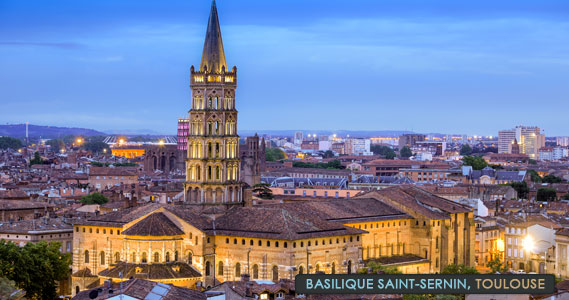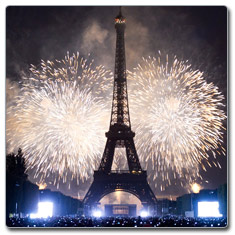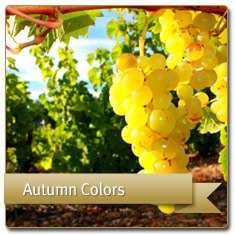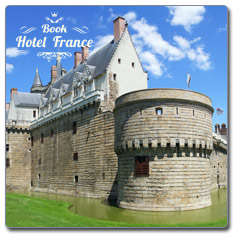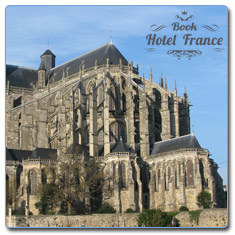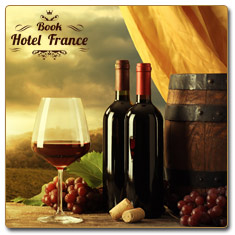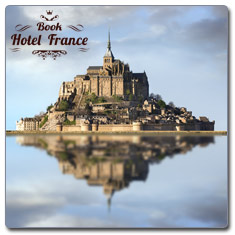Toulouse - La ville rose
From small Roman settlement to fourth largest city in France – that is Toulouse. City on the river Garonne, with buildings of red bricks, nicknamed La ville rose (The pink city) is today center of aviation and spaceflight, but in the past, its economy was based on pastel production. Just like its history, Toulouse is interesting and unique.
Toulouse was first mentioned by the name Tolosa, in the 2nd century, when it became Roman military outpost. Valley of the river Garonne, on which the city lies today, was very important geographical point for trade between Mediterranean sea and Atlantic ocean.
Not long after, in 5th century Toulouse was conquered by the Visigoths and became part of their kingdom. At the beginning of the 6th century Toulouse was one of the bigger and major cities in the kingdom, even served as a capital, but not for a long period. In 507 Franks attacked Toulouse and took it as part of Frankish realm. That time Toulouse became capital of Aquitaine.
Popular hotels in Toulouse
-
★★★ Hotel de Diane
20 minute drive from the centre featuring outdoor tennis courts, free wifi and each morning a breakfast buffet.
3 Route De Saint Simon, Toulouse -
★★★★★ Pullman Toulouse Centre
5 minute on foot from the Place du Capitole. With over 500m2 of space dedicated for meetings, it is the number one hotel for business trips.
84, allées Jean Jaurès, Toulouse
By the end of the 9th century, Toulouse managed to rise above other regions, and become capital of quasi-independent county, the county of Toulouse. County of Toulouse incorporated southern parts of Aquitaine and later added Gothia, expanding from city of Toulouse to the Rhone river. In theory they were supposed to be under sovereignty of the king of France, but in practice that didn’t work that way. Many dynasties from nearby provinces challenged them, but they survived for a long time, till 12th century.
In 12th century came difficult years for Toulouse. County was no longer ruled by count from Toulouse, but consuls. In the same time religious scuffle was at a start. Inquisition “knocked” on Toulouse door and they have answered, establishing Dominican Couvent des Jacobins right there in the city of Toulouse. Toulouse became capital of Inquisition which lasted 400 years.
Real end of independence of the county of Toulouse started in 1229, when it was submitted to the crown of France. Count of Toulouse had only one heiress, who was married to the brother of Lois IX of France. Marriage was childless, and after her death, county fell in hands of France. In 1271, Toulouse was listed as a “royal city” of France. That is when its transformation began. Toulouse developed as an intellectual and artistic center of France.
Unfortunately, that golden period was short-termed. Just hundred years from that period came downturn. First there was plague outburst, and soon after the Hundred Years' War. In just 70 years, population loss was 10.000, and the city of Toulouse was left with just 22.000 inhabitants.
Real golden age for Toulouse came in 15th century. City gained place as an administrative center, became richer, started trade of Toulouse wine with England, and found new trades, with cereals and textiles. Toulouse became producer of pastel, plant-based blue dye, which was very popular with artists throughout Europe. That amplified economical status of Toulouse even more. City finally flourished, economically and architecturally, like never before.
There were several setbacks from that period till 20th century. Plague again, disputes between Catholics and Protestants, Napoleonic wars, but Toulouse hold its position all the time.
With end of 19th century and beginning of the 20th century, Toulouse started to modernize. Train station was built, streets were widening, and new industries were brought to city - aircraft manufacturing and chemical factories. All of that to establish Toulouse as a modern city of France. New set of immigrants, from Algeria, former French colony, came in France in 1960s, particularly in Toulouse. That extended borders of the city even further.
Today, Toulouse developed industries like space exploration and electronics, and is fourth largest city in France.
In the heart of the Toulouse is Capitole. Today it houses municipal administration of the city, as well as opera company and symphonic orchestra - Théâtre du Capitole de Toulouse. Initially it was built in 12th century, when Toulouse became integrated part of France. The goal was to establish a seat for the government of a province. There were several reconstructions throughout time. Façade dates from 18th century and is done in Neoclassical style. Vast square in front of it, Place du Capitole, was redesigned in 20th century, and from 1995 it has area reserved for pedestrians. Be sure to visit Henri IV courtyard and gate, the only original parts of medieval building.
The Basilica of St. Sernin is church mainly constructed in the Romanesque style in 11-12th century. Building lies on the place of previous basilica built in 4th century. It was of high importance in 9th century as a stop on pilgrimage route to Santiago de Compostela in Spain. It is much larger than typical churches of its time. It has beautiful bell tower, with unique Romanesque arches, with addition of two extra tiers, built later in 14th century. It is listed as a UNESCO World Heritage site.
Le Couvent des Jacobins is the convent and the church from 13th century. Church has beautiful paintings, and well preserved Thomas Aquinas' relics. European mastery in building techniques can be seen inside the church on interesting “palm tree’ shaped columns. Cloister of the convent is right next to the church, and is open for the public, offering very quite and calm atmosphere.
One of newer and modern sights of Toulouse is Cité de l'espace (City of Space). It is located on the edge of Toulouse and as of 2012, it had more then 4 million visitors. Visitor can see full scale models of the Ariane 5 rocket, Mir space station, and Soyuz modules. There are two planetariums with regular presentations daily. Very interesting part of exhibition is interactive mock-up of control room, where visitors can participate in launching rocket, helping with its flight and placing satellite in orbit.
Pont Neuf, like the Parisian bridge of the same name, is the only old bridge in Toulouse. Built in 16th century, it has 7 arches, but it is unsymmetrical. The third arch from right-hand bank is the largest one. From there you have a beautiful view on the river Garonne.
There are two specialties of Toulouse region.
First is the duck, prepared in various forms – confit, dried, foie gras, etc. Many restaurants offer it and it is a delicious meal to try.
Second regional dish is cassoulet, which is a stew with white beans, duck, pork and herbs.
When you’re in Toulouse go to Rue Pargaminière, street in the city center, full with small restaurants and fast food corners. There is no chance you will leave with empty stomach.
For those who are searching for quiet atmosphere, but not to expensive restaurant, Aux Saveurs des Paradoux is a great choice.
It offers specialties like lobster, lamb stew, veal medallions and carpaccio of cherries. Prices are a little bit higher, but portions are generous, meals are fresh made and tasty, and French interior are all worth that price.
If you want to try something different than French cuisine, pay a visit to Chez Nous Les Libanais, small Lebanese restaurant, very popular with locals. For very low price you can eat fresh vegetables and Lebanese specialties.
Vegetarians must try La Faim des Haricots, restaurant that offers five “all you can eat” options, including salad, quiche, soup, main dish and dessert, and all of that has vegetarian option.
Toulouse has very popular rum bar called Cale Seche, located right next to Capitole. There is a variety of choices of rum. You can drink it as shot, or mixed in cocktails. Place can be crowded on weekends, when younger population prepares for night out.
Also good bars for a glass of beer or wine are La Capriciosa, El Cubano, and Saint Sernin.
Great way to spend nice day out of the city is to visit Carcassonne, small town, famous for its UNESCO World Heritage listed walled medieval fortress.
This was one of the places where movie Robin Hood: Prince of Thieves was filmed.
Town itself offers coffee corners, small restaurants and souvenir shops. It takes only an hour to get from Toulouse to Carcassonne, by train.
Another small town from UNESCO World Heritage list, located on the river Tam is Albi.
It is mostly built in red brick, so it has very interesting and unusual look.
In the town there is Toulouse-Lautrec museum and very beautiful old bridge, also done in red brick.
From Toulouse Albi is just an hour ride by train.
If you’re searching for nature getaway, very close to Toulouse there is Ariège.
Ariège is a Midi-Pyrenees region of France. It isn’t much known to tourists, mostly to the neighborhood French locals, who come here for vacation. It offers tranquility and relaxation from city noise, but it is great for hiking and camping. Just hour and half away from Toulouse there is a heaven, with hidden valleys, small villages and beautiful nature.
Toulouse d’Été is a summer festival, which takes place every year in Toulouse for several weeks. Concerts are held by the river, from jazz to electro music.
Historical buildings become venue for classical concerts. Even parks and train stations are transformed, and invite people to have a good time.
Long ago Toulouse was famous for purple flower - viola and even its economy was developed on it. Today many uses of this flower have been forgotten and that is why people of Toulouse celebrate each year Fête de la Violette. This festival is a chance to bring back old ages, and preserve some unique technique of use of flower viola.
Zoom Arrière is an annual film festival. But not like other film festivals that show new movies and current awarded acts, this festival in Toulouse shows respect to the old and forgotten ones. Each year with a different theme overlooked movies get their chance again.
Toulouse has its airport with regular domestic flights from and to Paris. Flight between Toulouse and Paris takes about 30 minutes. Other cities that are connected with Toulouse by plane are London, Munich and Frankfurt. There is an option of flying by cheap airline, to small towns nearby, like Beziers or Carcassonne, and from there catching train to Toulouse.
You can come to Toulouse by train from Paris, Toulouse or Marseille. Train ride from Paris takes around 5-6 hours. Special connection of Toulouse is with Andorra and Barcelona. 6 trains per day go in the direction of Pyrenees. All trains are direct to Andorra, but for Barcelona you have to change in Latour-de-Carol, but the whole trip doesn’t take more than 7 hours.
There are major highways to the city from Paris, Toulouse, Marseille and Barcelona, so if you’re coming by car, you can come to Toulouse from any side of the France, or Spain.


